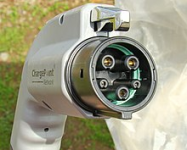Previously you were arguing that an EVSE isn't utilization equipment, so that the end of the J1772 cord is the outlet. Now you're arguing that it is utilization equipment?
The definition of utilization equipment is quite broad, and can be taken in the way you suggest. But I expect that will lead to various other problems in applying the NEC. It would make a lighted switch, a GFCI receptacle, an electronic circuit breaker, an occupancy sensor, etc., all utilization equipment. E.g. so every feeder supplying an electronic circuit breaker is now a branch circuit as well?
So that's a step too far for me, a little discretion is required. [Or maybe a PI is in order.] If the strict reading of outlet that I propose similarly led to such extensive issues, I'd gladly apply a little discretion to interpreting that as well. But I don't see that any similar conflicts arise.
Cheers, Wayne
P.S. I looked for that "is a switch an outlet" thread, and I found several later threads with links to it, but the links are now broken. In one of those later threads, Al recapped his basic argument as "a switch is a Controller, wiring internal to a Controller is exempted from the Premises Wiring System, and therefore there is an Outlet internal to the switch." Of course, this argument presumes that a switch has internal "wiring"; it's not clear to me that the conductors inside a typical snap switch would be considering wiring.

